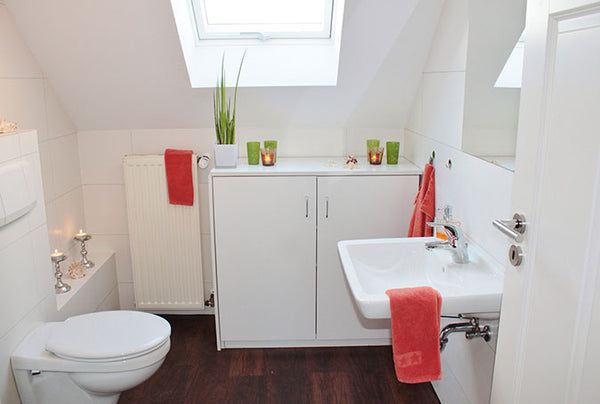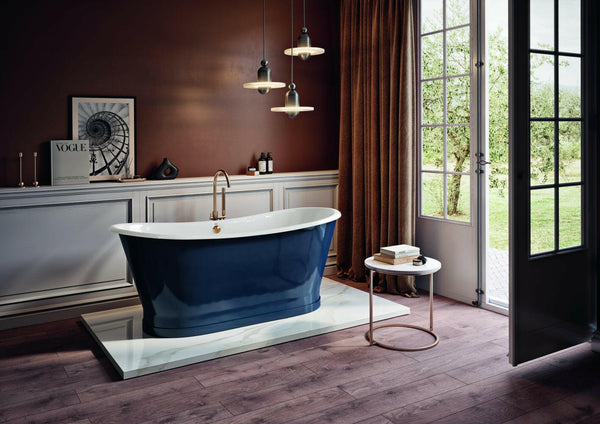Tiny houses were once reserved for eco-friendly hippies and off-the-grid mountain men. But thanks to shows like Tiny House Hunters and Tiny House Nation (plus scores of irresistibly cozy tiny homes on Pinterest), miniature living is more popular than ever.
And when it comes to planning and building a tiny house, even the smallest abodes require essentials such as a toilet, a sink and a shower. But what kind of bathware works best in mini homes, and what are tiny homeowners looking for?
If you’ve asked yourself these questions on the showroom floor, here’s what you should know about tiny homes, their small bathrooms and the people who own them.
What is a Tiny House?
Before we delve into the motivations behind tiny home building, let’s discuss what exactly classifies as a tiny home.
Different than a mobile home, cottage or cabin, Tiny House NZ says that a tiny home typically has a living area, sleeping loft, kitchen and bathroom arranged in a layout that optimizes space and efficiency.
As for size, writer Teresa Mears explains that tiny homes are usually less than 200 square feet, built on wheels, and designed to move from place to place.
The other type of small home is larger — usually reaching up to 1,000 square feet -— and is often built as a permanent structure on a parcel of land. Green Future points out that these small structures usually function as a traditional house, with standard plumbing and either solar or on-the-grid electricity.
Who Are Tiny Home Buyers?
When you’re marketing to tiny homeowners, it’s important to understand the target market. Thom Stanton, owner of tiny home building company Timber Trails, says that there are two main markets fueling the tiny home movement.
The first is retiring Baby Boomers, who are looking for a low-maintenance and affordable living situation. The other is Millennials, who may be struggling to purchase a home due to student loan debt and other financial challenges.
According to Dac Kopec, environmental psychologist and architect at the Boston Architectural College, tiny homes allow people to claim something as their own while also satisfying their need for mobility.
Another thing to keep in mind when working with tiny homeowners is that going small isn’t always a sacrifice. As Jill Lavigne explains on One Green Planet, small homes are often people’s only chance to build the homes of their dreams.
Why Do People Go Tiny?
When you’re marketing to people who live in tiny or small homes, it’s important to understand their motivations, values and desires for pursuing the small lifestyle.
Explaining the findings of modern environmental psychologists, Sarah Sloat says that people often opt for modest dwellings in pursuit of a simple lifestyle that also conserves resources. “Environmental consciousness, self-sufficiency and the desire for a life of adventure are all listed as inspirations for going small,” Sloat says.
Moving to a tiny house often presents a dramatic lifestyle change, but it can also provide exactly the kind of personal transformation that someone desires. This is what Outside Online writer Mark Sundeen discovered when he set out to determine the allure of small living. Sundeen explains how this transformation played out in the lives of many tiny homeowners he spoke to.
“Before tiny, there was an unhappy marriage, unpaid bills, stifling office work, a home of 2,500 square feet or more; after Tiny came freedom, new love, debt relief, self-employment, and, of course, a handmade nest,” Sundeed says.

Creating the Right Atmosphere
Despite the motivations and desires behind building a tiny home, many people may still be unclear about how exactly to create the atmosphere they desire.
For example, thetinylife.com owner Ryan Mitchell says the bathroom was the most challenging aspect of building his tiny house. Mitchell says that since this is the room where he spends the least amount of time, it was hard for him to find inspiration for creating the room.
That’s where you come in: Knowing what tiny homes are and how they work can create a stronger relationship between you and your tiny home customer.
Tiny Homes vs. Standard Homes
Tiny homes offer freedom and distance from big house living. Specifically, tiny homes rid of the responsibilities of owning a house — and all of the possessions it contains.
As BuzzFeed technology writer Doree Shafrir puts it, the effort of cleaning and maintaining a house over time is a major deterrent to buying a large house.
Another reason people are opting for smaller homes is due to mortgage debt and the feeling of being tied down to a specific home and place.
Laura LaVoie, author of the blog Life in 120 Square Feet, says having a mortgage on a 2,700-square-foot home in Atlanta made her and her partner feel trapped and financially unstable. Leaving their mortgage and building a tiny home, however, reduced their expenses and allowed them to pursue a life of financial freedom.

Function Over Form
Whether it’s a lofted bed or a kitchen that doubles as a closet, writer Devon Thorsby explains that tiny homes are always designed with functionality in mind.
Rather than asking “What furniture can we add?” or “What does this room need?” tiny home buyers ask “What don’t we need?” and “How can we maximize this space?”
Freshome writer Marina Resto agrees “Every design element in a small bathroom should have a purpose and be functional in some way or another,” she says.
In fact, tiny home builders don’t have a choice but to choose function over form. Microabode.com says small houses have to accommodate a toilet, a bath/shower and a sink all in one small space, so keep this in mind when marketing larger fixtures.
Tiny Bathroom Plumbing
While some tiny homeowners opt for an off-the-grid life, many others seek to create a more comforting or accommodating feel. So, when you’re selling to the latter group, it’s important to understand the logistics of a tiny house bathroom.
As for plumbing, tiny house dweller Ethan Waldman says there are a number of ways people might access water. For example, a tiny house owner might opt for no plumbing and choose to live self-sufficiently, or they might use a tank and pump system to circulate and pressurize the water.
More sophisticated tiny homes might include a hookup. This setup relies on traditional plumbing systems and needs to be hooked up to a water source where the house is located (or parked).
Sustainability and environmental efficiency are another core concern of those who opt for the tiny home lifestyle. As Tiny Green Cabins points out, small homes often use eco-friendly materials such as recycled blue jeans, locally harvested lumber and recycled metals.
When you’re helping customers browse and choose tiny home bathware, remember that water-efficient and sustainable appliances are likely a priority.
Tiny Bathtubs and Showers
Bathtubs probably aren’t the first things that come to mind when you think of tiny bathrooms. But as countless small home builders have shown, it is possible to have a soaker in even the smallest bathrooms.
Take the Escape Traveler home, for example. Jenny Xie, news editor at Curbed, says this dwelling features a unique layout in which a large kitchen and dining area are set between a lofted bathroom and living room. This creates extra space where a full size bathroom can fit comfortably.
Quebec-based building company Lumbec, Inc. also created a tiny house with a bathtub. Named Tiny House 2, the design features a 60-inch bathtub with an attached shower.
If you think that’s an amazing feat, Chris and Melanie Heininge’s custom house just might be more impressive. The Heininges managed to include a Jacuzzi-style tub into their 280-square-foot home, according to Oregonian design journalist Janet Eastman.
Knowing what tiny homeowners have achieved can come in handy if you encounter customers who are unsure about their bathroom needs.
images by: Pexels, Anja, Pexels






